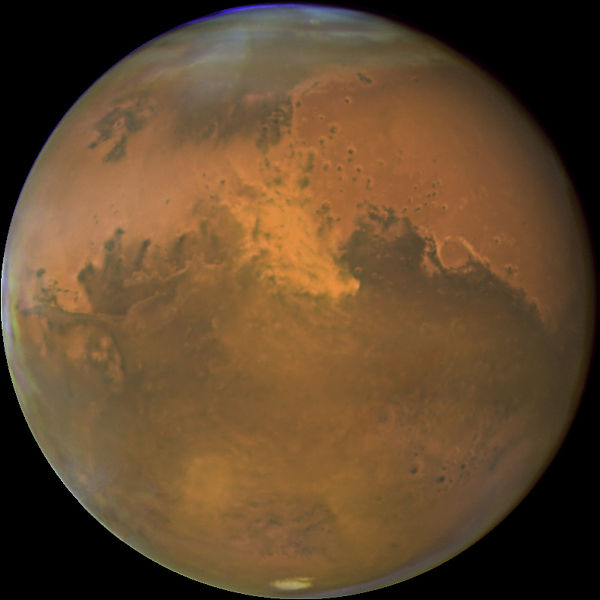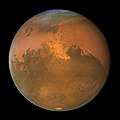Файл:2005-1103mars-full.jpg
Облик

Размер на този преглед: 600 × 600 пиксела. Други разделителни способности: 240 × 240 пиксела | 480 × 480 пиксела.
Оригинален файл (800 × 800 пиксела, големина на файла: 232 КБ, MIME-тип: image/jpeg)
История на файла
Избирането на дата/час ще покаже как е изглеждал файлът към онзи момент.
| Дата/Час | Миникартинка | Размер | Потребител | Коментар | |
|---|---|---|---|---|---|
| текуща | 16:52, 19 юни 2009 |  | 800 × 800 (232 КБ) | Tryphon | Higher resolution. |
| 01:21, 1 януари 2006 |  | 700 × 700 (34 КБ) | Pringles | NASA's Hubble Space Telescope snapped this picture of Mars on October 28, within a day of its closest approach to Earth on the night of October 29. Hubble astronomers were also excited to have captured a regional dust storm on Mars that has been growing |
Използване на файла
Следните 2 страници използват следния файл:
Глобално използване на файл
Този файл се използва от следните други уикита:
- Употреба в af.wikipedia.org
- Употреба в ca.wikipedia.org
- Употреба в el.wikipedia.org
- Употреба в en.wikipedia.org
- Употреба в en.wikiquote.org
- Употреба в en.wikiversity.org
- User:Marshallsumter/Radiation astronomy1/Planets/Sciences
- User:Marshallsumter/Radiation astronomy2/Reds
- User:Marshallsumter/Radiation astronomy/Chemistry
- User:Marshallsumter/Radiation astronomy1/History
- Solar System, technical/Classical planets
- User:Marshallsumter/Keynote lectures (draft)/Meteor radiation astronomy
- User:Marshallsumter/Radiation astronomy1/Planets/Classicals
- Draft:Original research/Planets
- User:Marshallsumter/Radiation astronomy2/Visuals/Quiz
- User:Marshallsumter/Rocks/Rocky objects/Astronomy
- User:Marshallsumter/Radiation astronomy/Courses/Principles/Hourly 2
- User:Marshallsumter/Radiation astronomy/Courses/Principles/Midterm quiz
- User:Marshallsumter/Radiation astronomy/Courses/Principles/Final quiz
- Titan/Quiz
- User:Marshallsumter/Rocks/Rocky objects
- Draft:Enceladus/Quiz
- Moon/Quiz
- Stars/Sun/Heliology/Quiz
- Earth/Quiz
- User:Marshallsumter/Radiation astronomy/Clouds
- User:Marshallsumter/Radiation astronomy/Cryometeors
- User:Marshallsumter/Radiation astronomy1/Lithometeors
- Stars/Reds/Quiz
- Draft:Dione/Quiz
- User:Marshallsumter/Radiation astronomy2/Scattered disks/Quiz
- User:Marshallsumter/Radiation astronomy1/Kuiper belts/Quiz
- WikiJournal Preprints/Cryometeors
- Употреба в es.wikipedia.org
- Употреба в fa.wikipedia.org
- Употреба в fr.wikipedia.org
- Употреба в fr.wikinews.org
- Употреба в gn.wikipedia.org
- Употреба в hi.wikipedia.org
- Употреба в hu.wikipedia.org
- Употреба в ia.wikipedia.org
Преглед на глобалната употреба на файла.

